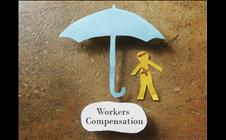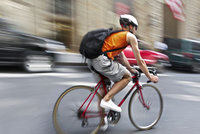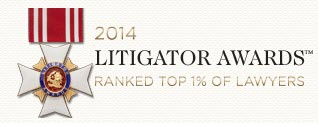I recently witnessed an automobile accident in the New York City suburb in which I live where no one was hurt, but plenty of damage was done to one of the vehicles involved. I was stopped at a red light directly behind the car that caused the accident. Ahead of that car was an SUV that was already backing into a parallel parking space when we both approached the red light and stopped. When the SUV was halfway into the parking space, the driver ahead of me tried to squeeze her car through the gap between the parking SUV and a truck waiting to turn left at the red light. I watched in amazement as the corner of the car’s bumper scratched its way up half the length of the parking SUV. The vehicles stopped where they were, and the at-fault driver immediately hopped out of her car and started screaming at her innocent victim that she had backed into her car while “speeding backwards into the parking space”. Nothing could have been further from the truth.
After 26 years as a personal injury attorney, I know that what gets reported on a police report by each of the drivers becomes the gospel for each of their insurance companies. If the driver of the car reported that the SUV had backed into her, the car’s insurance company would not only have refused to pay for the SUV’s damage, but would also likely have tried to recoup the car’s damages from the SUV’s insurance company. I was determined not to let that happen (and fortunately I happened not to be in a rush to get anywhere).
I parked my car up the street and came back to accident location where the drivers were waiting for the police to arrive. I introduced myself to the SUV driver and told her that I had witnessed the car accident from just 20 feet away and saw everything. I assured her that the accident was entirely the car’s fault, and that I intended to put my statement on the police accident report. I know from experience that insurance companies take non-party witness statements very seriously if they are contained on the police accident report.
This is when I learned how misinformed the police and most people are about what “No-Fault” means in New York State. A friendly suburban police officer arrived within minutes, looked at the cars, listened to the drivers tell their stories – one truthful, and the other full of lies – scribbled down their names in his memo book, and then told the drivers that he was not going to make a report because “this is a no-fault accident, so they don’t need an accident report”. “Excuse me officer,” I said politely, “but no fault has nothing to do with this”. “Who are you,” he asked to which I responded, “a witness”. He then told me that I could give the drivers my name if wanted to as he headed back to his car and drove away. I told the SUV driver to take lots of pictures of the vehicles where they were, exchange information with the other driver, and gave her my card, and said call me if and when you need me to give a statement.
The officer was wrong on two counts. This was NOT a “no-fault accident”, whatever that even means, and the drivers DID need a police report. Without getting too detailed, the Comprehensive Motor Vehicle Insurance Reparations Act, more commonly known as the New York No-Fault Law, became effective on February 1, 1974. The law was enacted to provide prompt payment of health related expenses and wage loss of those parties injured as a result of an auto accident. Under the No-Fault law, the insurance company for the vehicle an injured person is in when an accident occurs, pays that injured person’s medical bills and lost wages regardless of whose fault the accident is – ergo, “No-Fault”.
No-Fault, however, has nothing whatsoever to do with damage to cars involved in accidents, and fault has everything to do with who pays for collision damage. Simply put, if it’s another driver’s fault that a collision occurs, you are entitled to get your property damages from them, and to do so you must prove the accident was their fault. While No-Fault’s serious injury threshold does play some part in whether you can sue for personal injuries arising out of a car accident, again fault has everything to do with whether you can recover from the other driver for your pain and suffering.
If you sustain a serious injury in a car accident, you must prove that the accident was the other driver’s fault in order for you to recover from them. The statements made by the parties and witnesses on the police accident report is the first piece of evidence the insurance company looks at in determining fault for the happening of the accident. By not knowing what “No-Fault” was, the police officer deprived the drivers of the opportunity to make a report with a non-party witness statement included, which would have gone a long way to getting the insurance claims settled quickly. Instead the police officer’s ignorance will likely result in the SUV driver having to pay for her own damages, while the guilty careless car driver walks away without any consequences.
Again, “No-Fault” only applies to medical bills and lost wages, and you do not have the right to seek those from the other driver. You do, however, absolutely have the right to recover all other damages to your car, property and injury to your body from the driver and owner of the other vehicle, but to do so requires that you prove that the accident was their “yes-fault”. And, of course, remember to demand that the police fill out an accident report, even if the officer doesn’t know the law; because now you do.




 Each year, over 70 million tickets to Major League Baseball games are sold in cities across the country. Fans flock to these games for the live action – the opportunity to see their favorite players in the flesh, enjoy a few hot dogs and belt out the fan favorite “Take Me Out to the Ballgame” with thousands of other die-hards during the seventh inning stretch. Unfortunately, each year some of this “live action” causes injuries to spectators when a foul ball or flying bat (and occasionally, a player trying to get that heroic out) finds its way into the crowded stands. If you’ve witnessed one of these incidents or have been a victim of one, you’ve likely wondered what happens next? Will the team pay for medical care? Does the injured party have a right to sue?
Each year, over 70 million tickets to Major League Baseball games are sold in cities across the country. Fans flock to these games for the live action – the opportunity to see their favorite players in the flesh, enjoy a few hot dogs and belt out the fan favorite “Take Me Out to the Ballgame” with thousands of other die-hards during the seventh inning stretch. Unfortunately, each year some of this “live action” causes injuries to spectators when a foul ball or flying bat (and occasionally, a player trying to get that heroic out) finds its way into the crowded stands. If you’ve witnessed one of these incidents or have been a victim of one, you’ve likely wondered what happens next? Will the team pay for medical care? Does the injured party have a right to sue? If you have been injured in an accident, and another party is to blame, you may be able to obtain monetary damages from that person or business to compensate you for medical expenses, loss of income and pain and suffering as a result of the accident.
If you have been injured in an accident, and another party is to blame, you may be able to obtain monetary damages from that person or business to compensate you for medical expenses, loss of income and pain and suffering as a result of the accident. Each year, thousands of Americans take to the roads on bicycles. This mode of transportation is touted as being more cost-effective and more environmentally friendly than motor vehicles but when it comes to safety, cycling can come with a much greater risk. According to the National Highway Traffic Safety Administration, 39,000 individuals were injured in motor vehicle crashes in 2012. That same year, 724 cyclists lost their lives following accidents on the roads.
Each year, thousands of Americans take to the roads on bicycles. This mode of transportation is touted as being more cost-effective and more environmentally friendly than motor vehicles but when it comes to safety, cycling can come with a much greater risk. According to the National Highway Traffic Safety Administration, 39,000 individuals were injured in motor vehicle crashes in 2012. That same year, 724 cyclists lost their lives following accidents on the roads.






